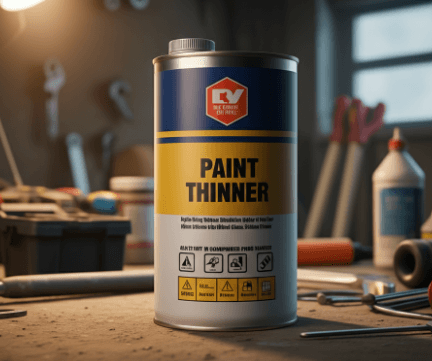Are you passionate about home improvement or DIY projects? Understanding how to use paint thinner effectively can significantly elevate the quality of your work. This comprehensive guide is designed to provide you with advanced techniques and essential knowledge on how to use paint thinner. Whether you’re a homeowner, a real estate investor, or a DIY enthusiast, incorporating paint thinner into your projects can enhance finishes and streamline cleanup efforts.
Paint thinner is a versatile solvent used by many, including real estate investors like Steve Daria and Joleigh, to maintain and refurbish properties. Prioritize adequate ventilation and wear protective gear like gloves and goggles for safe usage. Additionally, it is crucial to store paint thinner in a well-sealed container away from any sources of heat or flame.
What is Paint Thinner?
Before discussing how to use paint thinner, it’s crucial to understand that a paint thinner serves as a versatile solvent essential for various applications in painting and DIY projects.
Its primary function is to thin oil-based paints, varnishes, and stains by breaking down the oils and resins, thereby adjusting the paint’s viscosity for a more straightforward application.

Additionally, paint thinner effectively cleans painting tools such as brushes, rollers, and sprayers by dissolving and removing paint residues, ensuring they remain in optimal condition for future use.
Different Types of Paint Thinner
Understanding the variety of paint thinners available allows you to select the most appropriate one for your project.
Here are some commonly used options:
- Mineral Spirits: Ideal for thinning oil-based paints and varnishes.
- Turpentine: Known for its pungent odor, preferred by artists and artisans.
- Acetone: A powerful solvent used for tasks like nail polish removal and surface cleaning.
Benefits of Using Paint Thinner
Why should you integrate paint thinner into your DIY projects?
The benefits are extensive and impactful:
- Enhanced Paint Flow: Thinning paint improves its flow, resulting in a smoother finish.
- Efficient Cleaning: Simplifies the cleaning process for brushes, rollers, and other tools.
- Versatility: Extends beyond thinning paint, suitable for various cleaning and restoration tasks.
Get An Offer Today, Sell In A Matter Of Days
Preparing Your Workspace
Preparation is crucial for any successful DIY project, mainly when working with chemicals like paint thinner.
Safety Precautions
Paint thinner contains volatile organic compounds (VOCs) such as acetone, toluene, and xylene, which can pose health risks if mishandled. To ensure safety:
- Work in a well-ventilated area with windows and doors open to facilitate air circulation and prevent fume buildup.
- Wear appropriate protective gear, including nitrile gloves, safety goggles, and a respirator or mask rated for organic vapors.
- Keep the workspace free of open flames, sparks, or ignition sources to mitigate the high flammability of paint thinner.
- After use, securely seal the container to avoid spills and keep it in a cool, dry place far from direct sunlight and other heat sources.
Essential Tools
Equipping yourself with the right tools enhances efficiency and safety in handling paint thinner:
- Protective Gear: Gloves, masks, and goggles to shield against chemical exposure.
- Containers: Use metal or glass containers for mixing and storing paint thinner.
- Ventilation Equipment: Fans or exhaust systems to maintain adequate airflow during projects.
Advanced Techniques on How to Use Paint Thinner
Now that you have a foundational understanding let’s explore advanced techniques on how to use paint thinner in various applications.
Thinning Paint for Spraying
Achieving the correct paint consistency for spray applications requires precision:
- Measure Accurately: Use a measuring cup to ensure the precise ratio of paint to thinner.
- Mix Gradually: Add thinner gradually while stirring continuously to achieve the desired viscosity.
- Test Consistency: Conduct a test spray to assess the paint’s flow and coverage before applying it to your project.
Cleaning Painting Tools
Efficiently cleaning brushes and rollers after painting is essential for maintaining their longevity:
- Pre-Cleaning: Wipe off excess paint from tools using a rag or paper towel.
- Submerge and Swirl: Submerge the tools in paint thinner and swirl them to dissolve the remaining paint residue.
- Rinse and Dry: Rinse tools with warm water to remove paint thinner residues, then allow them to dry thoroughly before reuse.

Removing Paint from Surfaces
When you’re preparing surfaces for repainting or restoration, paint thinner proves invaluable for its exceptional paint removal capabilities.
Apply Generously
Begin by generously applying paint thinner-soaked cloth or rag onto the painted surface.
This application allows the thinner to penetrate deeply into the layers of old paint, softening them and making them easier to remove without damaging the underlying surface.
Scrub Gently
After allowing the paint thinner to sit and work on the layers, gently scrub the surface with a brush or scouring pad.
This gentle scrubbing action effectively loosens and lifts the softened paint residue from the surface.
Clean Residue
Once the paint has been sufficiently loosened, use a clean cloth to remove the softened paint and thinner residue.
This final step ensures that the surface is clean, smooth, and ready for the next coat of paint or restoration treatment.
Using paint thinner for removing paint is particularly beneficial when refurbishing old furniture, stripping paint from walls, or preparing surfaces with multiple layers of paint.
It offers a more efficient and less labor-intensive method compared to traditional scraping or sanding techniques, allowing you to achieve professional-quality results with less effort.
Conclusion
Mastering how to use paint thinner empowers you to achieve professional-grade results in your DIY and home improvement projects. Understanding its applications, safety precautions, and advanced techniques can enhance project outcomes and efficiency. Whether you’re thinning paint for a flawless finish or restoring old furniture, paint thinner is a valuable tool in your creative arsenal.
**NOTICE: Please note that the content presented in this post is intended solely for informational and educational purposes. It should not be construed as legal or financial advice or relied upon as a replacement for consultation with a qualified attorney or CPA. For specific guidance on legal or financial matters, readers are encouraged to seek professional assistance from an attorney, CPA, or other appropriate professional regarding the subject matter.

